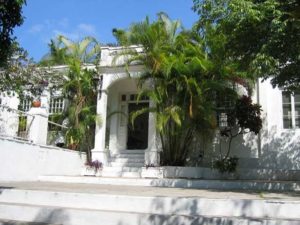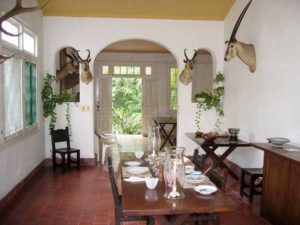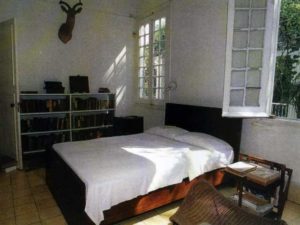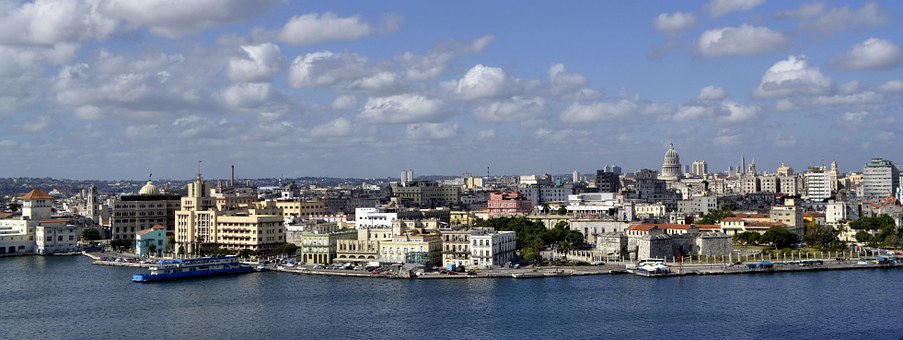 EXPERTOS DE MASSACHUSETTS RESTAURAN LA FINCA “LA VIGIA” HOGAR DE ERNEST HEMINGWAY EN LA HABANA, CUBA.
EXPERTOS DE MASSACHUSETTS RESTAURAN LA FINCA “LA VIGIA” HOGAR DE ERNEST HEMINGWAY EN LA HABANA, CUBA.
Un monumento nacional se asienta en un barrio de clase trabajadora fuera de La Habana. Se llama ‘Finca Vigia’, una traduccion al ingles como la casa de observación, y que una vez fue el hogar de Ernest Hemingway. La casa, construida a finales del siglo XIX por un arquitecto español, se asienta sobre una gran colina con vistas panorámicas de la capital cubana. La propiedad es exuberante con palmeras y árboles de bambú. También tiene una torre de vigilancia, una casa de huéspedes, una piscina que el escritor usaba todos los días, y su barco que ahora está en un dique seco, “El Pilar”.
El tiempo comenzó a desgastar la casa histórica, pero un proyecto exhaustivo para devolver a la Finca Vigia su antigua gloria acaba de alcanzar un hito importante gracias a un grupo de expertos de Massachusetts. Uno de esos conservacionistas es Bob Vila, el presentador del programa de televisión “This Old House”.
“Esto es representativo de la cultura estadounidense y el genio de la literatura estadounidense ubicada en uno de los lugares más polémicos de las Américas”, dijo. “Entonces, cuando piensas en el impacto que hemos podido tener en términos de amistad [y] construcción de puentes culturales, es algo realmente importante”.
Vila se desempeña como presidente del grupo Finca Vigia Foundation, con sede en Boston, que se formó hace quince años para salvar la casa de Hemingway, y su contenido, de los efectos de la madre naturaleza. Dijo que el sitio todavía tiene muchos problemas.
“La casa en sí se asienta en unos 10 acres que en realidad no han sido administrados o controlados en décadas”, dijo Vila.
Es un proyecto en curso, que se realiza en colaboración con el grupo cubano Consejo Nacional de Patrimonio Cultural. Y los expertos como Vila dicen que ahora tienen acceso a herramientas y recursos que nunca antes habían tenido.
Muchos de los manuscritos del escritor se han catalogado en formato digital en la Biblioteca Presidencial JFK en Boston, que alberga la mayor colección de Hemingway del mundo. Para algunas personas, puede parecer extraño que su trabajo se encuentre en la biblioteca, o en Boston, para el caso. Pero Hillary Justice, el becario de Hemingway de la biblioteca en residencia, dijo que no es tan extraño cuando aprendes más sobre la historia única entre el escritor y el presidente.
“Lo llamo un cuento de dos viudas”, dijo.
Justice explicó que Hemingway y Kennedy nunca se conocieron, pero la conexión comenzó cuando Kennedy le pidió permiso a Hemingway para usar la definición de valor del escritor para su autobiografía. Y después del suicidio de Hemingway en julio de 1961, el presidente le dio a Mary Hemingway un permiso especial para recuperar artículos personales de su hogar en La Habana, que de otro modo estaba prohibido para los estadounidenses.
Tras el asesinato del presidente Kennedy, Mary Hemingway ofreció los papeles de su difunto esposo para que los incluyera en la biblioteca JFK, que aún no se ha construido. Jackie Kennedy se sintió conmovida por la oferta y le escribió a Mary diciendo que estaría orgullosa de incluir los documentos en la biblioteca. Se dedicó un ala entera a esos papeles, pero el resto permaneció en Finca Vigia.
Cuando Jenny y Frank Phillips aparecieron en la casa en 2001, descubrieron que sus pertenencias aún no habían sido tocadas. Frank recordó el efecto visceral de ver los artefactos del escritor. “Recuerdo que cuando nos dejaron entrar por primera vez en la casa, algunas de sus ropas estaban allí”, dijo. “Jenny olió un poco la ropa y juró que olía a Hemingway”.
Poner en marcha el proyecto en la propiedad de La Habana no fue fácil. Debido al embargo estadounidense sobre Cuba, la restauración requirió un acuerdo entre los dos gobiernos. Uno se formó en 2004 con el apoyo del Congresista de Massachusetts Jim McGovern y Fidel Castro, y reunió a dos naciones políticamente opuestas para preservar el legado de una leyenda literaria que llamó hogar a los EE. UU. Y Cuba. Hemingway vivió en muchos países diferentes alrededor del mundo, pero él vivió en Cuba más tiempo que en cualquier otro lugar.
Izbel Ferreiro, directora ejecutiva del museo en Finca Vigia, mostró Morning Edition en la casa donde Hemingway terminó de escribir “Por quién doblan las campanas”. “Cuando se publicó el libro, fue un éxito”, explicó mientras caminaba por el casa, que se veía casi exactamente igual que cuando Hemingway estaba allí. “Paramount Pictures hizo una película … [Ellos] le pagaron a Hemingway $ 150,000, una gran cantidad de dinero en ese momento … Lo que hizo fue comprar la propiedad”.
Es donde se entregó a sus pasiones, desde la pesca hasta el entretenimiento. También es donde escribió su novela más exitosa y ampliamente publicada, “El viejo y el mar”.
“Es una casa hermosa”, dijo Frank Phillips. “Puedes ver a Hemingway en la casa. Y según mi esposa, puedes olerlo.
 EXPERTS FROM MASSACHUSETTS RESTORE ERNEST HEMINGWAY’S “FINCA LA VIGIA” WHERE HE LIVED IN HAVANA, CUBA.
EXPERTS FROM MASSACHUSETTS RESTORE ERNEST HEMINGWAY’S “FINCA LA VIGIA” WHERE HE LIVED IN HAVANA, CUBA.
A national landmark sits in a working-class neighborhood outside of Havana. It’s called Finca Vigia, or “Lookout Farm”, and it was once the home of Ernest Hemingway. The house, built at the end of the 19th century by a Spanish architect, sits on a large hill with sweeping views of the Cuban capital. The property is lush with palms and bamboo trees. It also has a look-out tower, a guest house, an in-ground swimming pool that the writer used every day, and his now dry-docked boat, ‘The Pilar’.
Time began to wear away at the historic house, but an exhaustive project to restore Finca Vigia to its former glory has just reached a major milestone thanks to a group of experts from Massachusetts. One of those preservationists is Bob Vila, the host of the TV show “This Old House.”
“This is representative of American culture and the genius of American literature located in one of the most controversial spots in the Americas,” he said. “So when you think about the impact we’ve been able to have in terms of friendship [and] cultural bridge-building, it’s really important stuff.”
Vila serves as president of the Boston-based group Finca Vigia Foundation, which was formed fifteen years ago to save Hemingway’s home — and the contents within it — from the effects of mother nature. He said the site still has a lot of problems.
“The house itself sits on about 10 acres that haven’t really been managed or controlled in decades,” Vila said.
It’s an ongoing project, being done in collaboration with the Cuban group Consejo Nacional de Patrimonio Cultural. And experts like Vila say they now have access to tools and resources they’ve never had before.
Many of the writer’s manuscripts have been cataloged in digital format the JFK Presidential Library in Boston, which is home to the largest Hemingway collection in the world. For some people, it might seem odd that his work is housed at the library, or in Boston for that matter. But Hillary Justice, the library’s Hemingway scholar in residence, said it’s not so strange when you learn more about the unique history between the writer and the president.
“I call it a tale of two widows,” she said.
Justice explained that Hemingway and Kennedy never met, but the connection began when Kennedy asked Hemingway for permission to use the writer’s definition of courage for his autobiography. And after Hemingway’s suicide in July of 1961, the president gave Mary Hemingway special permission to retrieve personal items from their home in Havana, which was otherwise off-limits to Americans.
Following President Kennedy’s assassination, Mary Hemingway offered her late husband’s papers to be included in the yet-to-be-built JFK Library. Jackie Kennedy was touched by the offer and wrote to Mary saying she’d be proud to include the papers in the library. An entire wing was dedicated to those papers, but the rest remained at Finca Vigia.
When Jenny and Frank Phillips showed up at the house back in 2001, they found his belongings were still untouched. Frank recalled the visceral effect of seeing the writer’s artifacts. “I remember when we were first allowed in the house, some of his clothes were there,” he said. “Jenny sniffed some of the clothes and swore she smelled Hemingway.”
Getting the project up and running at the Havana property wasn’t easy. Because of the U.S. embargo on Cuba, restoration required an agreement between the two governments. One was formed in 2004 with the support of Massachusetts Congressman Jim McGovern and Fidel Castro, and it brought two politically-opposed nations together to preserve the legacy of a literary legend who called both the U.S. and Cuba home. Hemingway lived in many different countries around the world, but he lived in Cuba longer than anywhere else.
Izbel Ferreiro, executive director of the museum at Finca Vigia, showed Morning Edition around the home where Hemingway finished writing “For Whom the Bell Tolls.” “When the book was published, it was a success,” she explained as she walked through the home, which looked almost exactly as it did when Hemingway was there. “Paramount Pictures made a movie… [They] paid Hemingway $150,000 — a lot of money at that time … What he did, he bought the property.”
It’s where he indulged his passions, from fishing to entertaining. It’s also where he wrote his most successful and widely published novel, “The Old Man and The Sea.”
“It’s a beautiful house,” Frank Phillips said. “You can just see Hemingway in the house. And according to my wife, you can smell him.”
Agencies/ WGBH/ Joe Mathieu/ Karen Marshall/ Shelby El Otmani/ Excerpts/ Internet Photos/ Arnoldo Varona/ www.TheCubanHistory.com
THE CUBAN HISTORY, HOLLYWOOD.



 < EXPERTS from Massachusetts restore Ernest Hemingway's "Finca La Vigia" in Havana, Cuba.
< EXPERTS from Massachusetts restore Ernest Hemingway's "Finca La Vigia" in Havana, Cuba.






